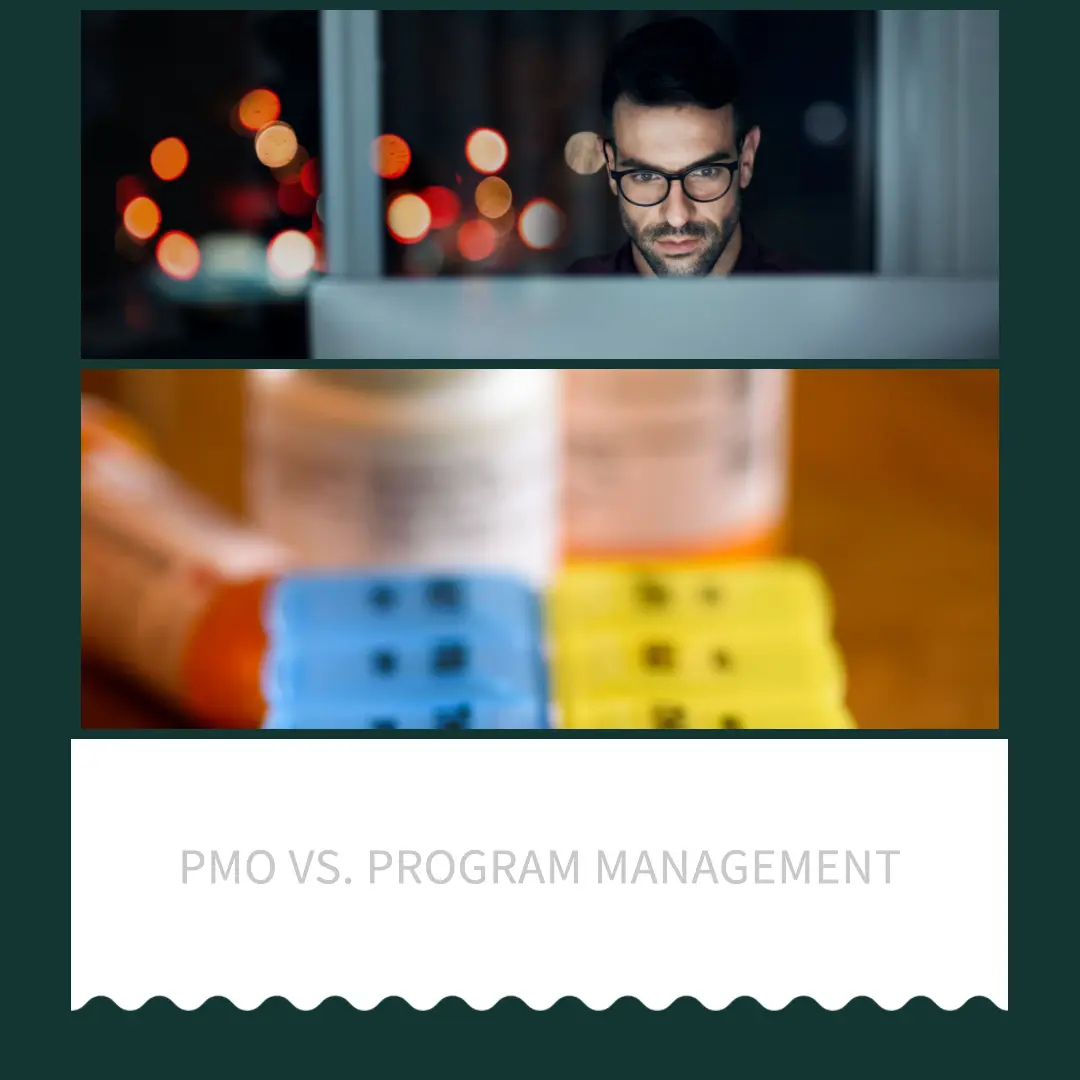I. Introduction
Hey there, fellow project management enthusiasts! Have you ever found yourself in a heated debate about PMO vs. program management? If so, you’re not alone. The world of project management can sometimes feel like a maze of terminology and concepts, which is why it’s essential to understand the differences between these two key players.
In today’s fast-paced and dynamic business environment, it’s more important than ever to effectively manage and execute projects. Organizations need to adapt and innovate to stay ahead, and project management plays a critical role in making that happen. So, whether you’re a project management professional or just interested in learning more, this blog post is for you.
We’ll dive deep into the distinctions between a PMO (Project Management Office) and program management, exploring their roles, responsibilities, and how they can impact an organization’s success. By the end of this post, you’ll have a clear understanding of these two concepts and be able to identify the best approach for your organization. So, without further ado, let’s get started!
II. PMO (Project Management Office)
A. Definition and purpose of a PMO
Before we dive into the nitty-gritty of PMOs, let’s start with a simple question: What exactly is a Project Management Office? In a nutshell, a PMO is a centralized team or department within an organization that’s responsible for defining and maintaining project management standards and practices. The main goal of a PMO is to improve the efficiency and effectiveness of project delivery across the organization.
B. Key roles and responsibilities
A PMO plays a vital role in ensuring project success. Let’s explore some of the main responsibilities that typically fall under a PMO’s purview:
- Standardizing project management practices: A PMO helps create a common language and set of processes for managing projects across the organization. This standardization can lead to improved communication, reduced duplication of efforts, and better project outcomes.
- Providing guidance and support for project managers: From mentoring and training to providing templates and tools, a PMO serves as a valuable resource for project managers, helping them navigate the complexities of their roles.
- Ensuring alignment with organizational goals: A PMO works closely with organizational leadership to ensure that projects align with strategic objectives and contribute to the overall success of the organization.
- Monitoring and evaluating project performance: A PMO is responsible for tracking the progress of projects, identifying potential issues, and providing recommendations for improvement. This helps ensure that projects stay on track and deliver the desired results.
- Resource management and allocation: A PMO assists in planning and allocating resources, such as personnel, budget, and equipment, to optimize project execution.
C. Types of PMOs and their specific functions
Not all PMOs are created equal! Depending on the organization’s needs, there are different types of PMOs with varying levels of authority and involvement. Here’s a quick rundown of the three main types of PMOs:
- Supportive PMO: This type of PMO primarily provides guidance, best practices, and resources to project teams. It has a low level of control and mainly acts as a facilitator.
- Controlling PMO: With a moderate level of control, a controlling PMO enforces compliance with project management standards and processes. It also plays a more active role in monitoring and evaluating project performance.
- Directive PMO: A directive PMO has the highest level of control and authority. It actively directs and manages projects, often assigning project managers from within the PMO itself.
Now that we have a better understanding of PMOs, let’s move on to program management and see how it compares!
III. Program Management
A. Definition and purpose of program management
So, we’ve covered PMOs, but what about program management? In essence, program management is the process of managing a group of related projects that are designed to achieve a common strategic objective or benefit. The main goal of program management is to optimize the delivery of value by coordinating resources, managing dependencies, and aligning projects with the organization’s strategic goals.
B. Key roles and responsibilities
Program management involves several critical responsibilities, which include:
- Managing a group of related projects: Program managers oversee a collection of projects that are interconnected and contribute to the achievement of a shared goal. They ensure that these projects are executed in a coordinated and efficient manner.
- Ensuring alignment with strategic objectives: Program managers work closely with organizational leaders to ensure that their program’s projects are in line with the organization’s strategy and contribute to its success.
- Coordinating resources and dependencies among projects: Program managers play a pivotal role in allocating resources, such as personnel, budget, and equipment, across the projects within their program. They also manage the dependencies and interactions between these projects to minimize risks and maximize benefits.
- Managing risks and benefits at the program level: Program managers identify, assess, and mitigate risks that could impact the entire program, rather than just individual projects. They also focus on realizing the benefits and value that the program as a whole can deliver to the organization.
- Facilitating communication and collaboration among project teams: Program managers act as a central point of contact and encourage open communication between project teams. This helps to ensure that everyone is on the same page and working together effectively.
C. The role of a program manager
- Difference between a program manager and a project manager: While both roles are crucial to an organization’s project management success, there are distinct differences between the two. A project manager focuses on the successful completion of a single project, while a program manager oversees multiple, related projects with a broader, strategic perspective.
- Skills and competencies required for a program manager: Program managers need a unique set of skills that go beyond traditional project management competencies. These include strategic thinking, leadership, stakeholder management, and the ability to manage complex interdependencies among projects.
Now that we’ve examined both PMOs and program management, it’s time to delve into their similarities and differences to gain a deeper understanding of how they compare.
IV. Comparing PMO and Program Management
A. Similarities between PMO and program management
At first glance, PMOs and program management may seem quite similar. After all, they both involve coordinating projects and resources to achieve organizational goals. Let’s look at some of the commonalities they share:
- Strategic alignment: Both PMOs and program managers work closely with organizational leadership to ensure that projects align with and contribute to the organization’s strategic objectives.
- Focus on value delivery: Both PMOs and program management aim to deliver value to the organization by optimizing project execution and ensuring the successful completion of projects.
- Resource coordination: PMOs and program managers both play a role in planning and allocating resources, such as personnel, budget, and equipment, across multiple projects.
B. Key differences between PMO and program management
Despite these similarities, PMOs and program management have distinct differences that set them apart:
- Scope and focus: While a PMO is typically concerned with standardizing processes and providing guidance for all projects within an organization, program management focuses on a specific group of related projects that share a common strategic objective.
- Roles and responsibilities: A PMO is responsible for defining and maintaining project management standards and practices, whereas a program manager actively manages a group of related projects and coordinates their resources and dependencies.
- Impact on the organization: PMOs often have a broader impact on the organization, as they help create a project management culture and drive consistency in project execution. In contrast, program management is more focused on the successful delivery of a specific set of related projects and their strategic outcomes.
- Reporting structure: PMOs typically have a more centralized reporting structure, with project managers reporting to the PMO. In program management, project managers may report directly to the program manager, who in turn reports to organizational leadership.
With these distinctions in mind, it’s essential to consider which approach best suits your organization’s needs. Let’s discuss how to make that choice.
V. Choosing the Right Approach for Your Organization
A. Factors to consider when deciding between a PMO and program management
So, how do you decide whether a PMO or program management is the best fit for your organization? There’s no one-size-fits-all answer, as each organization’s needs and goals are unique. However, here are some factors to consider when making your decision:
- Organizational size and complexity: Larger organizations with numerous projects and teams may benefit more from the standardization and guidance provided by a PMO. On the other hand, smaller organizations or those with a specific set of related projects might find program management to be more appropriate.
- Strategic objectives: If your organization has multiple strategic initiatives that require the execution of numerous related projects, program management can help ensure that these projects are aligned and coordinated effectively.
- Project management maturity: If your organization is still developing its project management practices, a PMO can provide the structure and support needed to improve and standardize these processes.
- Resource constraints: If your organization struggles with resource allocation and management across multiple projects, both PMOs and program management can help address these challenges. However, a PMO might offer a more comprehensive approach by focusing on resource management across the entire organization, while program management primarily addresses resource allocation within a specific set of related projects.
B. Examples of situations where a PMO or program management may be more appropriate
Let’s look at a couple of scenarios to better understand when a PMO or program management might be the right choice:
- PMO: Suppose your organization has a wide variety of unrelated projects, and you’re struggling to ensure consistency in project management practices. In this case, implementing a PMO could help create a common language, processes, and standards, leading to better project outcomes.
- Program Management: Imagine that your organization is launching a major strategic initiative that involves several interconnected projects, each with its own set of goals and deliverables. Program management could provide the focused oversight needed to ensure these projects are executed in a coordinated manner and deliver the desired strategic outcomes.
Ultimately, the choice between a PMO and program management depends on your organization’s specific needs and goals. By carefully considering the factors we’ve discussed, you can make an informed decision that best supports your organization’s project management success.
VI. Conclusion
And there you have it! We’ve journeyed through the realms of PMOs and program management, exploring their roles, responsibilities, and the differences that set them apart. As we’ve seen, both approaches play a crucial role in helping organizations manage and execute projects effectively. The key is to understand which approach best aligns with your organization’s unique needs and goals.
To recap, a PMO focuses on standardizing project management practices and providing guidance and support across the entire organization, while program management is concerned with overseeing a group of related projects that share a common strategic objective. Both approaches have their merits, and the right choice for your organization depends on factors such as size, strategic objectives, project management maturity, and resource constraints.
As you reflect on the insights shared in this blog post, I encourage you to evaluate your own organization’s project management needs and decide which approach – PMO or program management – will help drive your organization’s success. Remember, effective project management is crucial in today’s fast-paced, ever-changing business landscape, and the right approach can make all the difference.
So, go forth and conquer your projects, knowing that you’re armed with a deeper understanding of PMO and program management. Here’s to your project management success!
To find out how Artificial Intelligence is changing the Project Management landscape, you have enjoy reading this article https://www.shaunstoltz.com/did-artificial-intelligence-just-change-everything-about-project-management/
Find out more about Shaun Stoltz https://www.shaunstoltz.com/about/
This post was written by an AI and reviewed/edited by a human.



